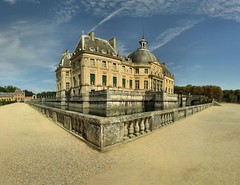When Louis XIV was crowned his interest in dancing was strongly supported and encouraged by Italian-born Cardinal Mazarin, (formerly Mazarini), who assiste Louis XIV. The young king made his ballet debut as a boy, but it was in 1653 as a teenager that he accomplished his most memorable feat as a dancer. He performed a series of dances in Le Ballet de la Nuit and for his final piece he appeared as Apollo, god of the sun. Wearing a fancy golden Roman-cut corselet and a kilt of golden rays he came to be known as the Sun King, says the-ballet.com.
Cardinal Mazarin promoted Italian influences in the French spectacle. The ballet master he imported from Italy was Giovanni Baptista Lulli, who was rechristened Jean Baptiste Lully for work in France. Lully became one of the king's favorite dancers and rivaled the king as the best dancer in France.
In 1661 Louis established the Académie Royale de Danse in a room of the Louvre, the world's first ballet school.
Also in 1661 he attended a party put on by the finance minister to show off his new home in the country. The entertainment was Molière's ballet Les Fâcheaux which pleased the king to no end, although he thought that the finance minister was a treasonous servant. As it turned out, the finance minister was arrested, and the ballet master, the home's architect, and the gardener were hired by the king.
A note on the unlucky minister from Wikipedia -
Once a small château located between the royal residences of Vincennes and Fontainebleau, the estate of Vaux-le-Vicomte was purchased by Nicolas Fouquet in 1641. At that time he was an ambitious twenty-six year-old member of the Parlement of Paris. Fouquet was an avid patron of the arts and attracted many artists with the gifts and encouragements he poured on them.
When Fouquet became King Louis XIV's superintendent of finances (Minister of the Economy, Finance and Industry (France)) in 1657, he commissioned Le Vau, Le Brun and Le Nôtre to renovate his estate and garden to match his grand ambition. Fouquet’s artistic and cultivated personality subsequently brought out the best in the three.[2]
To secure the necessary grounds for the elaborate plans for Vaux-le-Vicomte’s garden and castle, Fouquet purchased and demolished three villages. The displaced villagers were then employed in the upkeep and maintenance of the gardens. It was said to have employed eighteen thousand workers and cost as much as sixteen million livres.[3]
The château and its patron became for a short time a focus for fine feasts, literature and arts. The poet La Fontaine and the playwright Molière were among the artists close to Fouquet. At the inauguration of Vaux-le-Vicomte, a Molière play was performed, along with a dinner event organized by François Vatel, and an impressive firework show.[4]
[edit] Fête and arrest
The château was lavish, refined, and dazzling to behold, but these characteristics proved tragic for its owner: the king had Fouquet arrested shortly after a famous fête that took place on 17 August 1661 where Molière's play 'Les Fâcheux' debuted.[5] The celebration had been too impressive and the superintendent's home too luxurious. Fouquet's intentions were to flatter the King: part of Vaux-le-Vicomte was actually constructed specifically for the king, but Fouquet's plan backfired. - And with the same designers, Louis would create the extraordinary palace of Versailles.
At court, Molière and Lully collaborated, with Molière choreographing and Lully composing the music for ballets. Pierre Beauchamps, another ballet master, also worked with them choreographing interludes in the dramatic parts. Beauchamps eventually was named "superintendent of the king's ballets" in the dance school that Louis established in 1661 and is now one of the most famous of the "fathers" of ballet. It is Beauchamps who has been given credit for standardizing the five foot positions of ballet, (first through fifth positions).
In 1669 Louis, (still Louis XIV), established the Académie Royale de Musique for Lully to run. Then, in 1670 the king, past his physical prime, retired from dancing, allowing other, better dancers to take lead roles.
In 1672 Lully established a dance academy within the Académie Royale de Musique. This dance company survives today as the ballet of the Paris Opera - the world's oldest continuously running ballet company.
Lully's seriousness towards the study of dance led to the development of professional dancers as opposed to courtiers who could dance. Up until 1681 ballet was performed almost exclusively by men. Then, in 1681 Lully staged Le Triomphe de l'Amour, featuring Mademoiselle de Lafontaine, (1665-1738).
In 1687 Lully died from an injury he received by accidentally stabbing his foot with his time marking stick. At this time, ballet was normally performed in the same productions as opera, a theatrical form known as opéra-ballet.
In 1700 Choréographie, ou l'art de décrire la danse was published by Raoul Auger Feuillet. This book wrote down both conventions of stage and ballroom dancing and attempted to create a dance notation similar to music. Although this notation was never finalized and standardized, it is the system that is still in use today as no other system has been developed. The word choréographie gives us the English word choreography and is derived from the greek khorea, (to dance), and graphein, (to write). By 1700 many of the words and movements common in today's ballet were already in use, including jeté, sissone, chassé, entrechat, pirouette, and cabriole.
Subscribe to:
Post Comments (Atom)





No comments:
Post a Comment